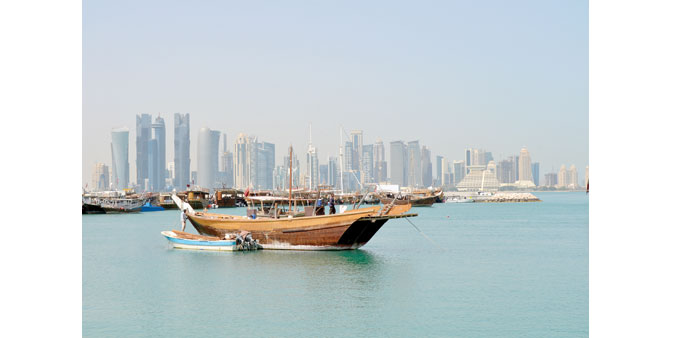A 2013 file photo of the Doha skyline. Photo by Sebbe XY
By Steff Gaulter
I’m often asked why it rains so little in Qatar. After all, the peninsula of Qatar is surrounded by water, so why aren’t there endless rain showers like there are in other hot parts of the world? Some friends of ours have just come back from a holiday in Kuala Lumpur where it rained every day. In Doha, however, it hardly ever rains.
Doha isn’t the only coastal city which is very dry. The capital of Peru also lies on the coast and sees even less rain than Doha. In fact Lima has the unenviable title of the driest capital city on earth. Whilst Doha bathes in 75mm (2.95 inches) of rain in a year, Peru’s capital receives a scanty 13mm (0.51 inches).
The reason Lima is so dry, despite its coastal position, is because the water that laps the shore is very cold. If the sea were warm, then moisture from the sea would evaporate into the air above it. The warmth would heat the air from below, causing humid air to rise. This air would cool as it rose and, as cold air can’t hold as much moisture as warm air, the moisture would condense into huge towering thunderstorm clouds and trigger rain. In Lima’s case, however, the cold coastal current suppresses the rainfall, creating a desert all the way along the coast.
The other reason that Lima is so dry, is due to the immense mountain range which lies to the east of the city. The Andes ensure that any rain that attempts to reach Lima from the east is blocked. With mountains blocking the rain from the east, and the cold current suppressing the rain from the west, Lima rarely sees rain.
In Doha, however, there must be a very different reason for our lack of rain. There are no mountains nearby to inhibit the rain, and the sea surrounding Doha is shallow so gets very warm in the summer months. In fact, for five months of the year the average sea temperature is over 30C (86F). So what is it that causes our lack of rain?
The answer to the riddle lies in the location of Qatar on the globe and how the sun moves during the year. Currently, the sun is tracking southwards, ready for the northern hemisphere’s winter. Later in the year, towards the end of December, the sun will reach its most southerly point, directly over the Tropical of Capricorn (23°30’ S). Conversely in June, the sun arrives at its most northerly point, the Tropic of Cancer (23°30’ N).
When the sun is directly overhead, the ground warms quickly and also heats the air above it. This causes the air to rise, creating showers. If you look at a satellite picture of the globe, there is a line of thunderstorms that extends all the way round the world. There are a few breaks in it, and a few regions where the showers are more intense, but you can trace it around the globe. It follows the sun north for the northern hemisphere’s summer, and southwards again for the winter.
After the air has risen and produced the towering thunderstorms, it becomes much drier. It then flows away, heading northwards or southwards, towards the Poles. However, the air is cooling all this time, and it doesn’t get as far as the Poles. In fact, it doesn’t get even nearly that far.
If you look at a map and point out some of the major desert regions, you will see that many of them are in a line. In the southern Hemisphere, the Great Victorian Desert in Australia, the Kalahari desert in southern Africa, and the Atacama Desert all lie on one line; and in the northern hemisphere, the enormous Sahara Desert, the Arabian Peninsula and North American’s Chihuahuan Desert all lie in another. This isn’t a coincidence.
The dry air slowly descends around 30°N and 30°S and this is the latitude of many major deserts. The descending air suppresses rainfall, ensuring that even if there is hot, humid air near the surface, which would normally be perfect for the formation of showers, the descending dry air high in the atmosphere inhibits any from forming.
Qatar lies on 25°N and is also affected by the descending air. It prevents all but the most vigorous storms making it to us, many simply petering out as they cross Saudi Arabia.
Between now and April, there is a greater chance of seeing a storm in Qatar as we are now in the wet season. ‘Wet’ is obviously a loose term, as the descending air will still affect us, so sunshine will still be the predominant type of weather. This ensures that most of us will still think that Doha is a very dry city, unless, of course, you come from Lima, in which case it may seem like it never stops raining.

